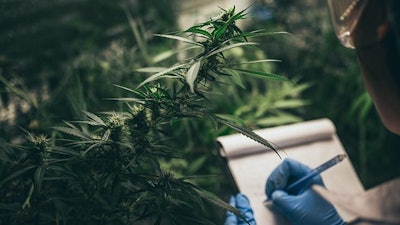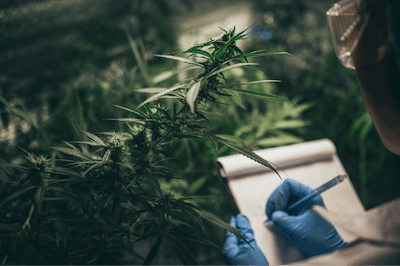

Decades of hemp prohibition have left knowledge gaps across all facets of hemp cultivation. But an ambitious project is beginning to fill many of those gaps with the help of growers across the Midwest.
Four university extensions have banded together to collect a mass of data from cannabinoid hemp cultivators to compile in a free, interactive tool online called the Midwestern Hemp Database (MHD). The MHD has a plethora of information, from soil types and planting methods Midwestern producers used in the 2020 season to the varieties they grew and how they performed.
But the interactive tool is just phase one of a larger effort. This year, in addition to continuing with the MHD project, the university extensions are partnering with growers in four different states to facilitate regional field trials with the cultivars that showed the most promise based on the MHD data from 2020.

It’s an effort that has allowed the universities to fast-track information collection for use by both regional cultivators and researchers. Their unique approach also allowed them to conduct research with minimal physical contact in the era of COVID-19.
“It came from almost a sense of desperation,” says Phillip Alberti, an extension educator of commercial agriculture for University of Illinois Extension, about the data collection project on which he has taken the lead. “In so many cases, when we do research, we have foundational data that we can build off of … . But we didn’t really have any of that, and we knew that so many growers were going to be doing this regardless of what data they had in front of them. They were just so excited to try a new crop, and ... we just figured we could really use their expertise, their skill, and learn from them as well.”
MHD Takeaways
During the summer of 2020, the university extensions of Michigan, Illinois, Wisconsin and Purdue (Indiana) sought out growers focusing on cannabinoid production to share cultivation data and crop samples in exchange for discounted testing thanks to a partnership with Rock River Laboratory Inc., based in Wisconsin. (While the testing did not take the place of state-mandated THC testing, it did allow cultivators to track cannabinoid levels throughout the season.)
The research team provided cultivators with strict sampling protocols and tools to reduce error. Growers were required to send in samples of each variety for testing at least twice throughout the season.
More than 130 growers across the Midwest participated in the project, submitting more than 750 samples for cannabinoid profiling.
The database reveals common agronomic practices throughout the region, as well as how 115 different hemp cultivars performed during the season in terms of flower development, cannabinoid content and overall yields. From the MHD, growers can find out, for example, the cultivars that tested hot above the 0.3% THC limit in the area (which may have been related to factors aside from genetics, like variation in cultivation practices); when most people in their area were planting and harvesting; and what flower yields they can expect per plant, just to name a few key metrics.
The MHD’s uses are plentiful. First and foremost, it allows cultivators to make educated decisions on which genetics will work for them in their area based on their own production practices.
It has also already played a tangible role in developing hemp regulations. In its final rule on hemp, the U.S. Department of Agriculture (USDA) cites data from the MHD in a few important areas, which ultimately played a role in the agency updating the harvest-sampling window from 15 to 30 days as well as adding flexibility to sampling procedures for testing.
“Pretty cool, right? Growers are submitting data in, and it gets to be used as science informing policy as it’s happening, so we’re pretty proud of that,” Alberti says.
The data also revealed interesting preliminary genetic information about hemp. While previous studies have found a positive correlation between cannabidiol (CBD) and THC ratios in hemp, data from the MHD suggests cannabigerol (CBG) may not have the same connection with THC. In fact, according to the information received from cultivators, CBG-dominant cultivars appeared to have “much lower” THC than CBD-dominant cultivars, Alberti says.
“We want to look into this more, but there might be some potential for CBG cultivars to be a little less problematic with hot hemp,” Alberti says, stressing that more research is needed to study the relationship between cannabinoids. “I think it’s important for growers to understand that not all cannabinoids will exhibit very clear relationships with THC.”
The data also set the stage to take a closer look at which cultivars may be best suited for growers in the region.
“It typically takes a few years to gather this much info,” Alberti says. “Now that we have this baseline, we can focus on the specific details.”
Upcoming Trials
The MHD researchers are now looking to partner with 20 experienced hemp farmers across the four different states to participate in trials this summer. The growers will be given seed for five different cultivars that showed the most potential from the 2020 season based on the MHD data. The costs of seed, testing, and shipping for cannabinoid analysis will be covered.
“We’re using that first set of data to … gather which varieties have potential,” Alberti says. “We put them in the cultivar check program to really examine them further, and then hopefully we can make some serious recommendations to growers within the next year or two about, ‘These are compliant, stable cultivars or good sources of genetics for you to work with.’”
While Alberti could not yet name the exact cultivars they will be trialing, he says the team developed a list of requirements to vet the top-performing cultivars from the MHD. Those being tested for 2021 were shown last year to test below the legal THC limit, have 5% CBD content or higher, and produce at least 1 pound of flower per plant.
Growers will be required to take samples at three, five and seven weeks after flowering.
Researchers want to test if the varieties that performed well last season will produce consistent results, including stable CBD and THC ratios.
“We’ve seen a tremendous amount of variation from year to year, and also within seed lots, from companies in the past, so we want to make sure that the varieties they’re pushing out year after year are truly genetically stable and are going to produce well,” Alberti says.
The researchers are also looking to see how fast cannabinoids develop and how their concentrations vary over time, which would eventually allow cultivators to pinpoint an ideal harvest window for the cultivars without testing.
In the meantime, data collection for the MHD will be ongoing. The project has expanded for this year to include growers in Kentucky, Ohio and Iowa as well.
“The nice thing about this is it’s going to constantly evolve and expand,” Alberti says.














